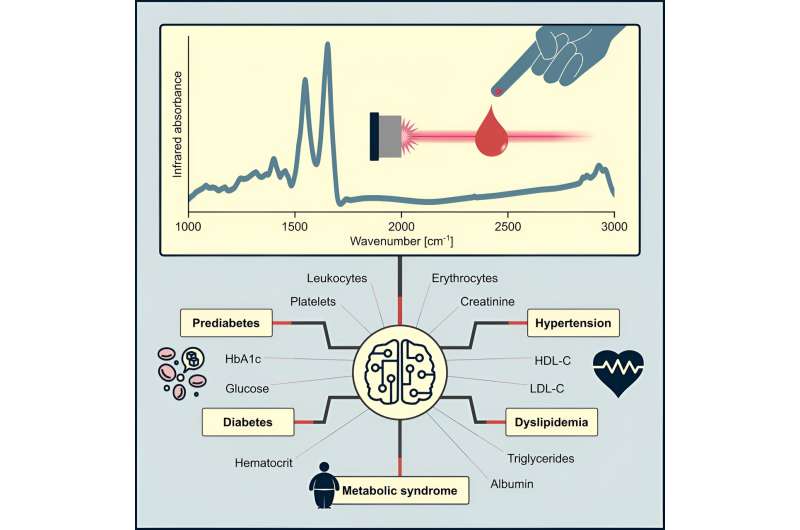This article has been reviewed according to Science X's editorial process and policies. Editors have highlighted the following attributes while ensuring the content's credibility:
fact-checked
peer-reviewed publication
trusted source
proofread
One drop of blood, many diagnoses: Infrared spectroscopy for screening health

Envision a scenario where a single drop of blood provides comprehensive health insights within minutes. Thanks to recent scientific advancements, this vision may become reality.
Scientists from the BIRD team led by Mihaela Žigman at Ludwig-Maximilians-Universität München (LMU) and the Max Planck Institute of Quantum Optics (MPQ), in collaboration with Helmholtz Zentrum München, have developed a health screening tool that uses infrared light and machine learning to detect multiple health conditions with just one measurement. The work is published in Cell Reports Medicine.
Infrared spectroscopy, a technique that employs infrared light to analyze the molecular composition of substances, has been a foundational tool in chemistry for decades. It's like giving molecules a fingerprint that can be delivered by a specialized machine called a spectrometer.
When applied to complex biofluids like blood plasma, this physico-chemical technique can reveal detailed information about molecular signals, making it a promising tool for medical diagnostics. Despite its long-standing use in chemistry and industry, infrared spectroscopy has not been established nor integrated into the canon of medical diagnostics.
Led by Mihaela Žigman, a team of scientists from the BIRD group at LMU and MPQ initiated an effort to tackle this issue. Having previously established a method for measuring human plasma, they collaborated with Annette Peters' team from Helmholtz Munich to pioneer infrared molecular fingerprinting on a naturally diverse population.
This involved measuring blood from thousands of individuals in the KORA study, a comprehensive health research project established in Augsburg, Germany. Randomly selected adults were chosen as a representative scenario for a naturally variable population and were recruited for medical examinations and blood donations.
Extensive potential applications
What is the value of the current work? The existing KORA study got a new value as it got tested from a fresh perspective and served a new purpose: More than 5,000 blood plasma samples were measured using Fourier transform infrared (FTIR) spectroscopy. Tarek Eissa and Cristina Leonardo of the BIRD team at LMU analyzed the blood samples from the KORA study using infrared light to obtain molecular fingerprints. The team applied machine learning to analyze the molecular fingerprints and correlated them with medical data.
They discovered that these fingerprints contain valuable information that enables rapid health screening. A multi-task computer algorithm that is now capable of distinguishing between various health states, including abnormal levels of blood lipids, various changes in blood pressure, seeing type-2 diabetes but also spotting even pre-diabetes, a precursor to diabetes often undetected.
Interestingly, the algorithm could also single out individuals who were healthy and remained healthy over the investigated years. This was very significant for two reasons. First, most people in any random population experience abnormal health changes and, given that we are all different, as well as that we all change over time, it is all but trivial to find fully healthy individuals. Second, many individuals suffer from multiple conditions in various combinations. Traditionally, doctors would need a new test for each disease.
However, this new approach doesn't just pinpoint one condition at a time—it accurately identifies a range of health issues. This machine learning-powered system not only identifies healthy individuals but also detects complex conditions involving multiple illnesses simultaneously. Moreover, it can predict the development of metabolic syndrome years before symptoms appear, providing a window for interventions.
This study lays the groundwork for infrared molecular fingerprinting to become a routine part of health screening, enabling doctors to detect and manage conditions more efficiently, the researchers say. This is especially important for metabolic disorders such as cholesterol abnormalities and diabetes, where timely and effective interventions can significantly improve outcomes.
However, the potential applications of this technology extend even further. As researchers continue to refine the system and expand its capabilities, by means of technology development and the establishment of these in the context of clinical studies, there will be even more health conditions and their combinations added to the diagnostic repertoire, the researchers hope.
This could lead to personalized health monitoring, where individuals regularly check their health status and catch potential issues long before they become serious.
The combination of infrared spectroscopy with machine learning is set to transform health diagnostics, the researchers believe. With a single drop of blood and infrared light, there will be a powerful new tool to keep tabs on our health, catching problems more efficiently and potentially improving health care globally.
More information: Tarek Eissa et al, Plasma infrared fingerprinting with machine learning enables single-measurement multi-phenotype health screening, Cell Reports Medicine (2024). DOI: 10.1016/j.xcrm.2024.101625



















